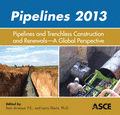Anchor Block Design Made Easy
Publication: Pipelines 2013: Pipelines and Trenchless Construction and Renewals—A Global Perspective
Abstract
Anchor blocks are a key component of many above-ground pipelines. Anchor blocks are typically used in waterworks applications where thrust restraint of a pipeline is desired. Some design guidance can be obtained from several sources including Steel Penstocks, Second Edition, ASCE Manuals and Reports on Engineering Practice No. 79. However, the analysis and design of anchor blocks for waterworks applications could use some improvements for easy use in the design office. This paper will address the fundamentals of designing anchor blocks for elevated welded steel pipe and will explore the geometry and mathematics with emphasis on design simplicity. Significant computational advantage can be obtained by application of vector algebra to resolve forces that often act along the pipeline axes. Further computational simplification is possible by approximating the center of gravity of the anchor block, recognizing a volume is calculated by revolution of a planar section and application ("Pappus's Centroid Theorem". A common design issue is what to do when stability cannot be achieved economically by adding more concrete weight? Adding rock anchors to provide stability is typically more cost-effective than adding weight. The goal of this paper is to provide a useful tool to pipeline designers who may have struggled in the past with design issues related to anchor block design. An example problem is included. Figure 1 indicates an idealized anchor block for an elevated, welded-steel penstock where geometry of the bend is defined. The anchor block is constructed of reinforced concrete and the steel penstock passes through it as indicated in Section A. Often for constructability and forming purposes, concrete anchor blocks are built with multiple straight-sided surfaces with tangents that extend beyond the points of tangency of the bend. Analysis of the component prisms that make up an anchor block can make calculations of volume and center of gravity very tedious and complex. In order to simplify calculations, an idealized anchor block is substituted as shown in Figure 1 where a planar section is rotated about an axis forming a geometric solid of revolution. With this figure, simple calculations can be performed to compute volume and center of gravity with reasonable accuracy, recognizing that a precise model requires more computational effort. Typical anchor block forces include: (1) the axial forces acting along the penstocks reach both upstream and downstream of the anchor block and include gravity loads from penstock and water, friction loads from pipe supports, friction loads from expansion joints, and pressure loads acting on ends of expansion joints and internal pressure; (2) the fixed-end beam moments and shears acting at the faces of the anchor block where the penstock penetration occurs; and (3) the gravity load from the anchor block itself that includes components of weight from concrete, water, and steel within the anchor block. To properly evaluate all the effects of all the above forces requires very detailed calculations. However, the author believes that reasonable preliminary design accuracy can be obtained by selecting the primary loads only that include (1) destabilizing force from internal pressure force acting at the anchor block along the bend bisector together with (2) stabilizing force from the anchor block weight. Resolution of forces and moments about the base of the anchor block is necessary to calculate, sliding and overturning stability and bearing stresses. The selection of a plane to perform the analysis should be based upon an understanding of the geology of the site however, Line "A" in Figure 1, located near the base of the anchor block at right angle to the bend bisector has been chosen for illustration. The mid-point of Line "A" is the location where summing of forces and moments is performed. Typically the anchor block alone is inadequate to provide stability and the addition of weight in the form of pre-stressed rock anchors will assist in attaining stability.
Get full access to this article
View all available purchase options and get full access to this chapter.
Information & Authors
Information
Published In
Copyright
© 2013 American Society of Civil Engineers.
History
Published online: Jun 25, 2013
Authors
Metrics & Citations
Metrics
Citations
Download citation
If you have the appropriate software installed, you can download article citation data to the citation manager of your choice. Simply select your manager software from the list below and click Download.
